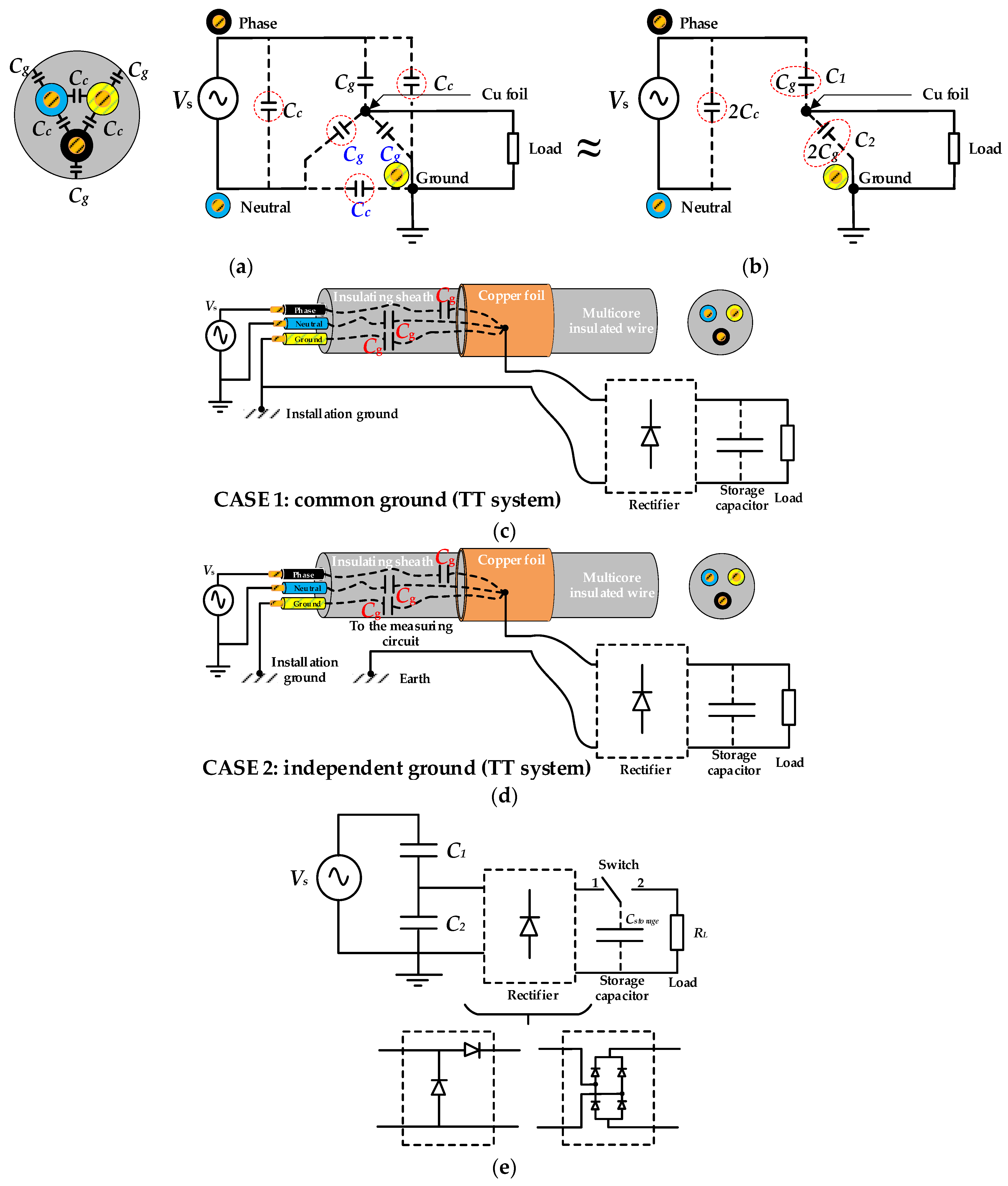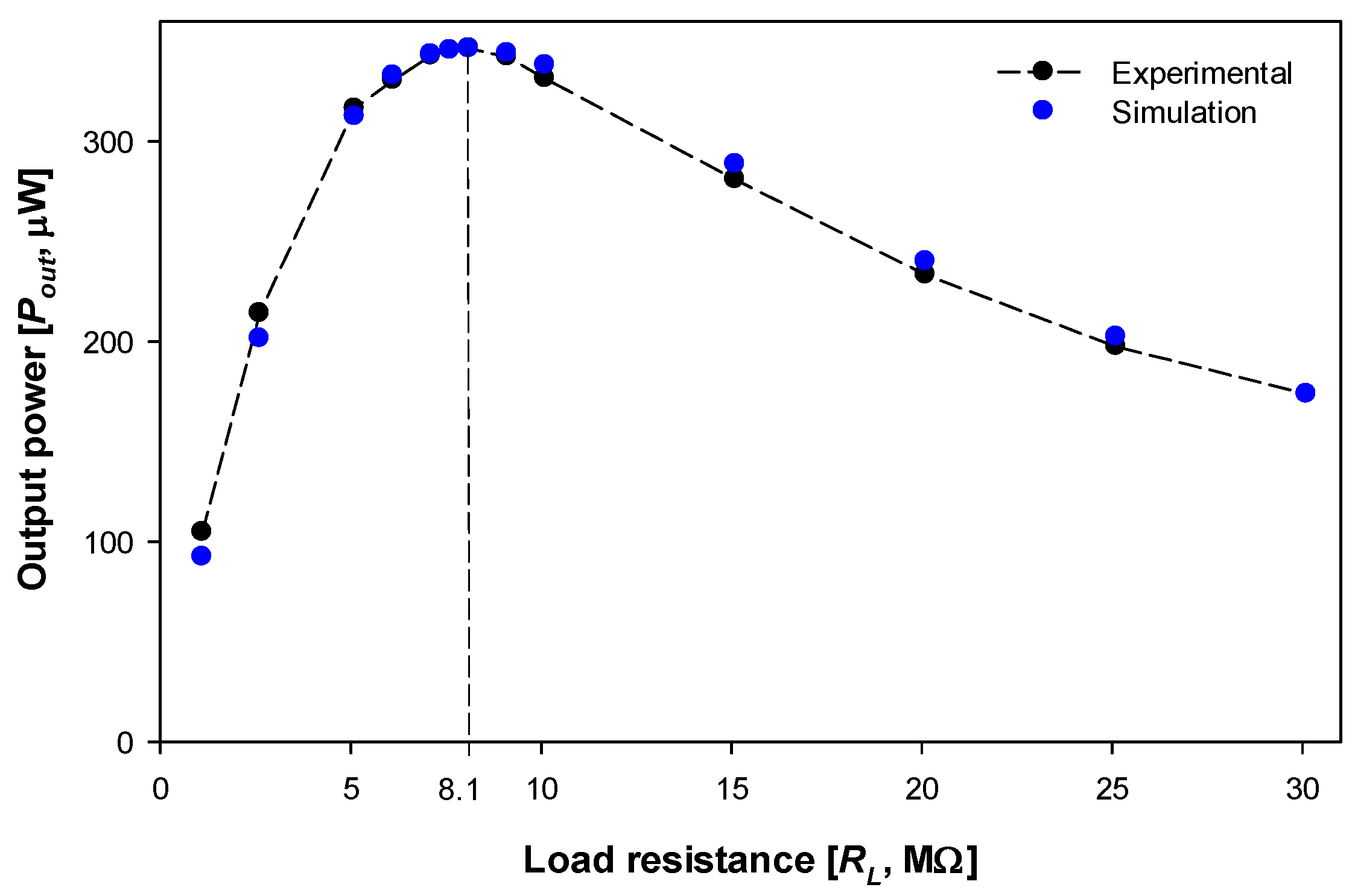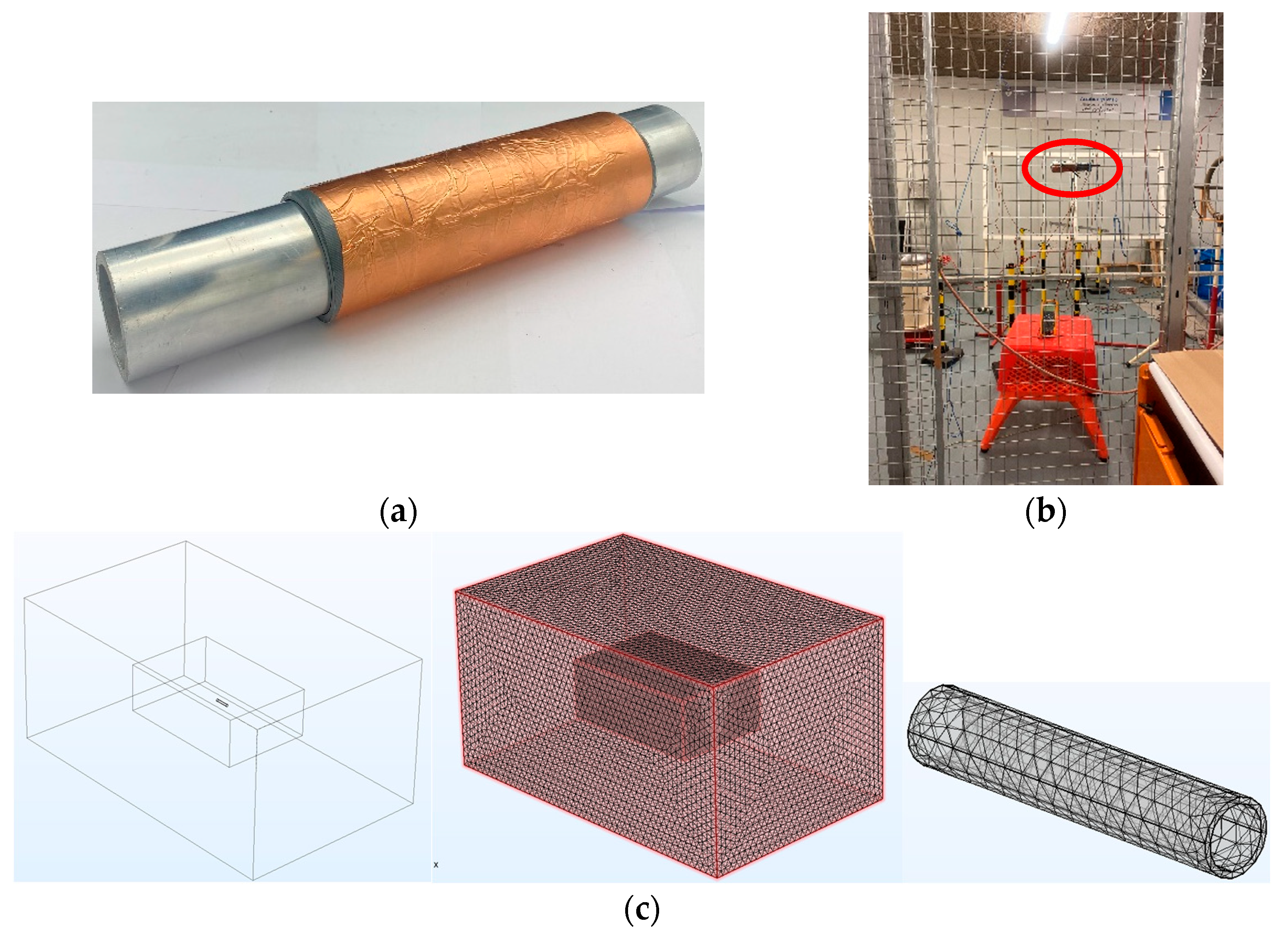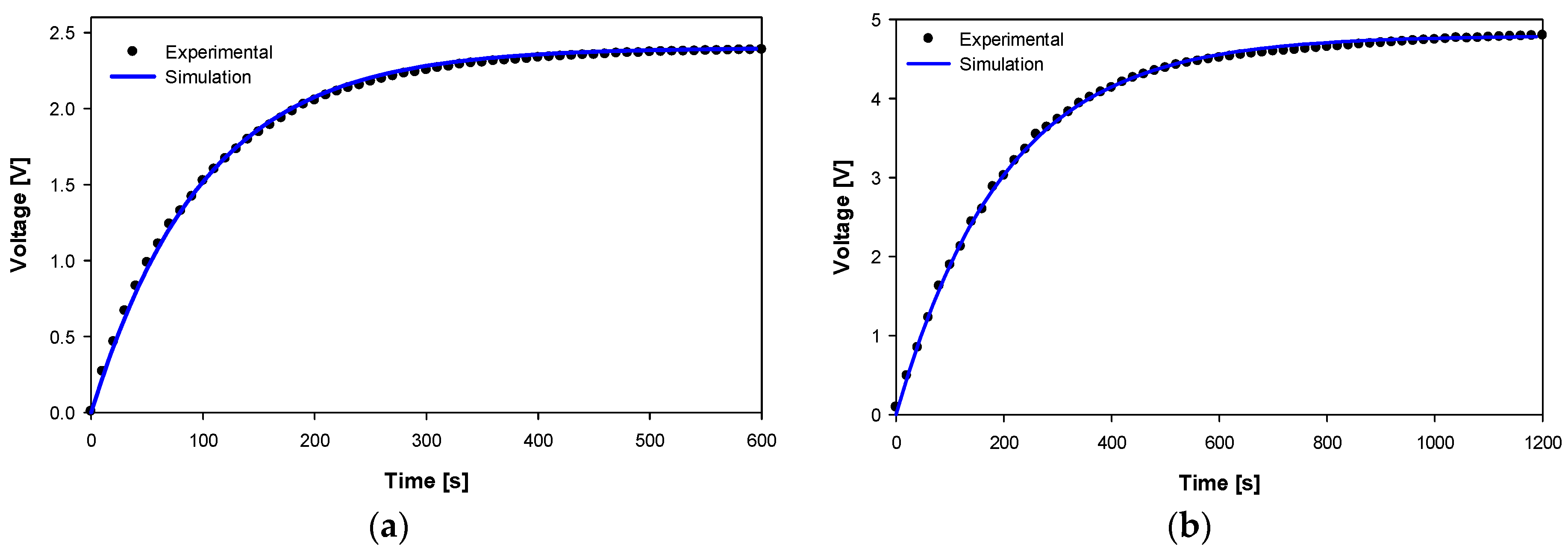Exploring the Limitations of Electric Field Energy Harvesting
Abstract
:1. Introduction
2. EFEH for Low-Voltage Multicore Insulated Wires
3. EFEH for High-Voltage Overhead Power Lines and Substation Bus Bars
4. Experimental Results
4.1. Experimental and Simulation Results with the Low-Voltage Multicore Insulated Wire
4.2. Experimental and Simulation Results with High-Voltage Power Lines and Substation Bus Bars
4.2.1. Calculation of the Capacitances C1 and C2
4.2.2. Experimental and Simulation Results with the High-Voltage Cylindrical Bus Bar
4.3. Concluding Remarks
- ▪
- The results presented in this paper clearly show that when applying EFEH strategies, a limited amount of energy and power can be harvested, so low-power or ultra-low-power (ULP) wireless sensor nodes are required.
- ▪
- The results presented in Section 4.1 and Section 4.2 clearly show that the supply voltage Vs largely determines the energy harvesting potential, so that EFEH for high-voltage applications results in higher harvested energies.
- ▪
- The output voltage Vout also increases linearly with the supply voltage in both low- and high-voltage systems.
- ▪
- In general, high-voltage systems are preferred for EFEH because the high voltage supply tends to produce higher capacitive currents. However, high-voltage systems require greater insulation distances, i.e., the distances between live parts and ground, which reduces capacitive coupling and therefore the value of C2. It has been shown that it is possible to harvest power from typical residential voltages of 230 V due to the higher capacitive coupling. Although the energy harvested in low-voltage applications is lower than in high-voltage applications, the increased capacitive coupling partially compensates for the voltage limitations of EFEH in low-voltage systems. Therefore, there is a trade-off between voltage level and capacitive coupling, the latter depending on the insulation distance, since as this distance increases, the value of C2 and the potential for energy harvesting decrease.
- ▪
- For low-voltage systems, the harvester capacitance C1 in the layout shown in Figure 1 has a large effect on the output voltage Vout because C1 and Vout are proportional. Therefore, longer harvesters increase the energy scavenged.
- ▪
- For high-voltage systems (see Figure 2), the value of C1 has almost no effect on the output voltage or the energy harvested. This means that the dimensions of the harvester have little effect on the energy harvested.
- ▪
- Since the performance of EFEH systems depends on the values of the stray capacitances, the results are not always fully repeatable because the parasitic capacitance can be affected by external factors such as the effects of nearby grounded objects or environmental variables such as humidity or temperature [27].
- ▪
- It has also been observed in both low- and high-voltage applications that the output voltage Vout increases almost linearly with the value of the load resistance RL. However, the load resistance depends on the power of the electronic circuit associated with the harvester, which is usually less than a few MΩ.
- ▪
- By adding a diode rectifier and a storage capacitor Cstorage, the DC output voltage is almost independent of the value of Cstorage.
- ▪
- The use of a two-diode rectifier is advantageous over a four-diode rectifier due to the reduced number of components and the results obtained, which are almost the same.
- ▪
- By increasing the value of Cstorage, more energy can be stored and used by the electronic circuit. However, for a given resistive load, the time required to charge the capacitor increases with the product τ = RL·Cstorage, where τ is the time constant, thus reducing the frequency of the communications. Therefore, the size of Cstorage must be accurately calculated to store enough energy for all sensing and communication cycles while maximizing the number of communication cycles per day.
- ▪
- The effective value of the load resistance RL depends on the power required by the rest of the circuit (sensor module, DC/DC converter, microprocessor, and communication module). In a real circuit, it changes cyclically with the load level of Cstorage and the phase of the communication cycle (advertising parameter initialization, advertising start, transmission, delay, and sleep), exhibiting a cyclic load profile.
- ▪
- The final power available to the load depends strongly on the efficiency of the control circuit, which is a key point for the commercialization of EFEH-based sensors.
5. Conclusions
Author Contributions
Funding
Data Availability Statement
Conflicts of Interest
References
- Zhou, J.; Zhang, J.; Xu, C.; Fang, L.; Wang, Y.; Zhuang, Y.; Jia, T.; Huang, Y.; Han, C. On the improvement of electric field energy harvesting from domestic power lines. AEU-Int. J. Electron. Commun. 2022, 155, 154349. [Google Scholar] [CrossRef]
- Riba, J.-R.; Moreno-Eguilaz, M.; Bogarra, S. Energy Harvesting Methods for Transmission Lines: A Comprehensive Review. Appl. Sci. 2022, 12, 10699. [Google Scholar] [CrossRef]
- Roscoe, N.M.; Judd, M.D. Harvesting energy from magnetic fields to power condition monitoring sensors. IEEE Sens. J. 2013, 13, 2263–2270. [Google Scholar] [CrossRef]
- Hernández-Guiteras, J.; Riba, J.-R.; Romeral, L. Improved design of an extra-high-voltage expansion substation connector through magnetic field analysis. Simul. Model. Pract. Theory 2014, 43, 96–105. [Google Scholar] [CrossRef]
- Liu, Y.; Riba, J.R.; Moreno-Eguilaz, M.; Sanllehí, J. Application of Thermoelectric Generators for Low-Temperature-Gradient Energy Harvesting. Appl. Sci. 2023, 13, 2603. [Google Scholar] [CrossRef]
- Ahmed Abdulkadir, A.; Al-Turjman, F. Smart-grid and solar energy harvesting in the IoT era: An overview. Concurr. Comput. Pract. Exp. 2021, 33, e4896. [Google Scholar] [CrossRef]
- Prajwal, K.T.; Manickavasagam, K.; Suresh, R. A review on vibration energy harvesting technologies: Analysis and technologies. Eur. Phys. J. Spec. Top. 2022, 231, 1359–1371. [Google Scholar] [CrossRef]
- Muscat, A.; Bhattacharya, S.; Zhu, Y. Electromagnetic Vibrational Energy Harvesters: A Review. Sensors 2022, 22, 5555. [Google Scholar] [CrossRef]
- Yang, F.; Du, L.; Yu, H.; Huang, P. Magnetic and Electric Energy Harvesting Technologies in Power Grids: A Review. Sensors 2020, 20, 1496. [Google Scholar] [CrossRef]
- Cetinkaya, O.; Akan, O.B. Electric-Field Energy Harvesting in Wireless Networks. IEEE Wirel. Commun. 2017, 24, 34–41. [Google Scholar] [CrossRef]
- Moghe, R.; Yang, Y.; Lambert, F.; Divan, D. A scoping study of electric and magnetic field energy harvesting for wireless sensor networks in power system applications. In Proceedings of the 2009 IEEE Energy Conversion Congress and Exposition, San Jose, CA, USA, 20–24 September 2009; pp. 3550–3557. [Google Scholar] [CrossRef]
- Zangl, H.; Bretterklieber, T.; Brasseur, G. Energy harvesting for online condition monitoring of high voltage overhead power lines. In Proceedings of the 2008 IEEE Instrumentation and Measurement Technology Conference, Victoria, BC, Canada, 12–15 May 2008; pp. 1364–1369. [Google Scholar] [CrossRef]
- Kim, H.; Choi, D.; Gong, S.; Park, K. Stray electric field energy harvesting technology using MEMS switch from insulated AC power lines. Electron. Lett. 2014, 50, 1236–1238. [Google Scholar] [CrossRef]
- Chang, K.; Kang, S.; Park, K.; Shin, S.; Kim, H.S.; Kim, H. Electric Field Energy Harvesting Powered Wireless Sensors for Smart Grid. J. Electr. Eng. Technol. 2012, 7, 75–80. [Google Scholar] [CrossRef]
- Sabovic, A.; Delgado, C.; Subotic, D.; Jooris, B.; De Poorter, E.; Famaey, J. Energy-Aware Sensing on Battery-Less LoRaWAN Devices with Energy Harvesting. Electronics 2020, 9, 904. [Google Scholar] [CrossRef]
- Kadechkar, A.; Moreno-Eguilaz, M.; Riba, J.-R.; Capelli, F. Low-Cost Online Contact Resistance Measurement of Power Connectors to Ease Predictive Maintenance. IEEE Trans. Instrum. Meas. 2019, 68, 4825–4833. [Google Scholar] [CrossRef]
- Zhang, J.; Li, P.; Wen, Y.; Zhang, F.; Yang, C. A management circuit with upconversion oscillation technology for electric-field energy harvesting. IEEE Trans. Power Electron. 2016, 31, 5515–5523. [Google Scholar] [CrossRef]
- Kang, S.; Yang, S.; Kim, H. Non-intrusive voltage measurement of ac power lines for smart grid system based on electric field energy harvesting. Electron. Lett. 2017, 53, 181–183. [Google Scholar] [CrossRef]
- Zhao, X.; Keutel, T.; Baldauf, M.; Kanoun, O. Energy harvesting for overhead power line monitoring. In Proceedings of the International Multi-Conference on Systems, Signals & Devices, Chemnitz, Germany, 20–23 March 2012. [Google Scholar] [CrossRef]
- Rodriguez, J.C.C.; Holmes, D.G.; McGrath, B.P.; Teixeira, C. Energy Harvesting from Medium Voltage Electric Fields using pulsed flyback conversion. In Proceedings of the 2016 IEEE 8th International Power Electronics and Motion Control Conference (IPEMC-ECCE Asia), Hefei, China, 22–26 May 2016; pp. 3591–3598. [Google Scholar] [CrossRef]
- Gulati, M.; Parizi, F.S.S.; Whitmire, E.; Gupta, S.; Ram, S.S.S.; Singh, A.; Patel, S.N.N. CapHarvester: A Stick-on Capacitive Energy Harvester Using Stray Electric Field from AC Power Lines. Proc. ACM Interact. Mob. Wearable Ubiquitous Technol. 2018, 2, 1–20. [Google Scholar] [CrossRef]
- Khan, M.R.; Islam, M.A.; Rana, M.M.; Haque, T.; Joy, S.I.I. A Circuit Model for Energy Harvesting from Fringing Electric Fields for Mobile Wearable Device Applications. Energies 2021, 14, 7016. [Google Scholar] [CrossRef]
- Moser, M.J.; Bretterklieber, T.; Zangl, H.; Brasseur, G. Strong and weak electric field interfering: Capacitive icing detection and capacitive energy harvesting on a 220-kV high-voltage overhead power line. IEEE Trans. Ind. Electron. 2011, 58, 2597–2604. [Google Scholar] [CrossRef]
- Zhao, X.; Keutel, T.; Baldauf, M.; Kanoun, O. Energy harvesting for a wireless-monitoring system of overhead high-voltage power lines. IET Gener. Transm. Distrib. 2013, 7, 101–107. [Google Scholar] [CrossRef]
- Riba, J.-R.; Capelli, F. Analysis of capacitance to ground formulas for different high-voltage electrodes. Energies 2018, 11, 1090. [Google Scholar] [CrossRef]
- Liu, Y.; Riba, J.R.; Moreno-Eguilaz, M. Energy Balance of Wireless Sensor Nodes Based on Bluetooth Low Energy and Thermoelectric Energy Harvesting. Sensors 2023, 23, 1480. [Google Scholar] [CrossRef] [PubMed]
- Shruti, H. Designing a Capacitive Sensing System for a Specific Application; Cypress: London, UK, 2011; pp. 1–14. [Google Scholar]








| Vs [V-RMS] | RL [MΩ] | Vout [V-RMS] Exp./Sim. 1 | Pout [μW] Experimental | Vout,max [V-DC] Exp./Sim. 2 | |
|---|---|---|---|---|---|
| Common ground | 115 V | 0.10 | 0.46/0.45 | 2.12 | 0.20/0.20 |
| 0.20 | 0.93/0.90 | 4.32 | 0.43/0.41 | ||
| 0.39 | 1.79/1.76 | 8.22 | 0.84/0.80 | ||
| 0.50 | 2.27/2.25 | 10.31 | 1.10/1.02 | ||
| 1.00 | 4.54/4.48 | 20.61 | 2.19/2.03 | ||
| 5.00 | 19.59/19.69 | 76.75 | -/9.40 | ||
| 230 V | 0.10 | 0.91/0.92 | 8.28 | 0.40/0.41 | |
| 0.20 | 1.87/1.85 | 17.48 | 0.82/0.83 | ||
| 0.39 | 3.70/3.60 | 35.10 | 1.68/1.61 | ||
| 0.50 | 4.64/4.61 | 43.06 | 2.06/2.05 | ||
| 1.00 | 9.22/9.17 | 85.01 | 4.17/4.06 | ||
| 5.00 | 38.48/38.75 | 296.14 | -/18.80 | ||
| Independent ground 3 | 115 V | 0.10 | 0.19 | 0.36 | - |
| 0.20 | 0.41 | 0.84 | - | ||
| 0.39 | 0.85 | 1.85 | - | ||
| 0.50 | 1.09 | 2.38 | - | ||
| 1.00 | 2.26 | 5.11 | - | ||
| 5.00 | 10.18 | 20.73 | - | ||
| 230 V | 0.10 | 0.37 | 1.37 | - | |
| 0.20 | 0.79 | 3.12 | - | ||
| 0.39 | 1.65 | 6.98 | - | ||
| 0.50 | 2.13 | 9.07 | - | ||
| 1.00 | 4.46 | 19.89 | - | ||
| 5.00 | 19.67 | 77.38 | - |
| RL [MΩ] | Vout [V-RMS] Measured | Vout/Vout,0.1MΩ | Vout [V-RMS] Simulated | Pout [mW] Experimental | |
|---|---|---|---|---|---|
| 0.10 | 5.3 | 1.00 | 5.3 | 0.3 | |
| 0.20 | 10.6 | 2.00 | 10.6 | 0.6 | |
| 20 kV | 0.39 | 20.7 | 3.91 | 20.8 | 1.1 |
| 0.50 | 26.1 | 4.92 | 26.7 | 1.4 | |
| 1.00 | 52.3 | 9.87 | 53.3 | 2.7 | |
| 0.10 | 13.3 | 1.00 | 13.4 | 1.8 | |
| 0.20 | 26.9 | 2.02 | 26.7 | 3.6 | |
| 50 kV | 0.39 | 52.0 | 3.91 | 52.0 | 6.9 |
| 0.50 | 66.4 | 4.99 | 66.7 | 8.8 | |
| 1.00 | 132.7 | 9.97 | 133.2 | 17.7 |
Disclaimer/Publisher’s Note: The statements, opinions and data contained in all publications are solely those of the individual author(s) and contributor(s) and not of MDPI and/or the editor(s). MDPI and/or the editor(s) disclaim responsibility for any injury to people or property resulting from any ideas, methods, instructions or products referred to in the content. |
© 2023 by the authors. Licensee MDPI, Basel, Switzerland. This article is an open access article distributed under the terms and conditions of the Creative Commons Attribution (CC BY) license (https://creativecommons.org/licenses/by/4.0/).
Share and Cite
Riba, J.-R.; Arbat, R.; Ndong, Y.O.; Moreno-Eguilaz, M. Exploring the Limitations of Electric Field Energy Harvesting. Electronics 2023, 12, 3626. https://doi.org/10.3390/electronics12173626
Riba J-R, Arbat R, Ndong YO, Moreno-Eguilaz M. Exploring the Limitations of Electric Field Energy Harvesting. Electronics. 2023; 12(17):3626. https://doi.org/10.3390/electronics12173626
Chicago/Turabian StyleRiba, Jordi-Roger, Ricard Arbat, Yaye Oumy Ndong, and Manuel Moreno-Eguilaz. 2023. "Exploring the Limitations of Electric Field Energy Harvesting" Electronics 12, no. 17: 3626. https://doi.org/10.3390/electronics12173626
APA StyleRiba, J.-R., Arbat, R., Ndong, Y. O., & Moreno-Eguilaz, M. (2023). Exploring the Limitations of Electric Field Energy Harvesting. Electronics, 12(17), 3626. https://doi.org/10.3390/electronics12173626








